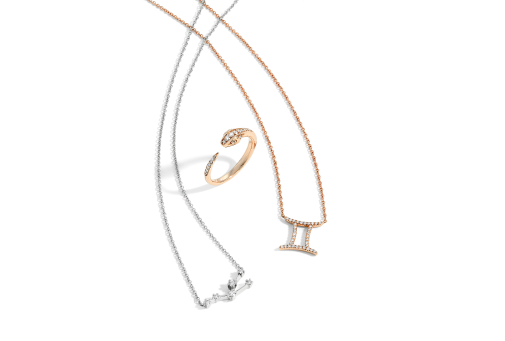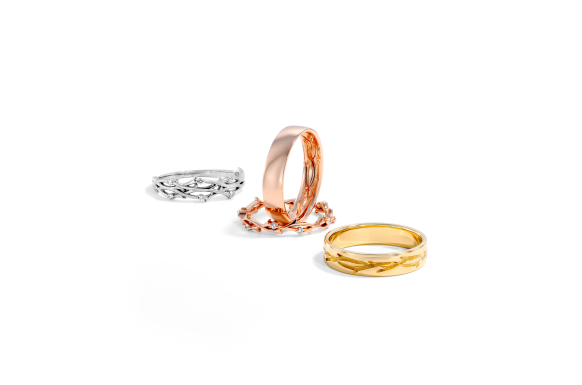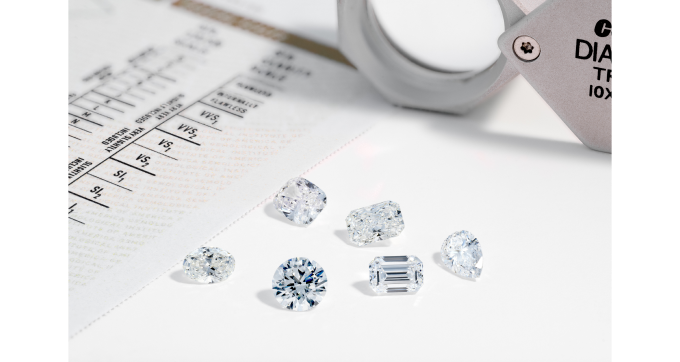Diamonds and metal are a perfect match, but you may wonder if diamond is a metal. Like metal, diamond is shiny, hard, and mined from the ground… And yet, diamond is not a metal. Still scratching your head? Let’s find out why!
Is diamond a metal?
Although diamonds are extremely hard, they are not metal. Here are the main reasons:
Diamonds don’t melt under heat or pressure
Both diamond and metal can withstand extreme conditions, but sustained heat or pressure will melt a metal. Diamond forms under conditions that would melt metals like gold, silver, and platinum. In its solid form, diamond is resistant to heat and cannot be melted. It can still melt - but at temperatures above 4,000 C/7,000 F. This means a rocket engine doesn’t run hot enough to melt a diamond. In other words… Diamond is exceptionally strong, the hardest naturally-occurring substance known to man. It can melt, but only under the most extreme conditions.
Diamonds don’t conduct electricity
Diamond is the last material you need if you want to create an electrical connection! Diamond resists the movement of electricity through it, acting as an electrical insulator. Unlike metals or graphite, diamond has no free electrons in its structure that can move to create an electrical current. Ultra-strong carbon-carbon bonds occupy every electron present in the diamond superstructure so they simply cannot flow.
A wide range of industrial processes and electronics applications use diamond as an electrical insulator. Scientists have even been able to alter the composition of synthetic diamonds to induce electrical conductivity.
Diamonds cannot be shaped
The creation of a diamond is always a once-in-a-lifetime event! You cannot reshape a diamond once it has formed. The ingenious crystalline structure of diamond develops under powerful forces. Once these subside, the tightly-bonded arrangement of a diamond is unchangeable.
Reshaping diamond requires a phenomenal amount of energy to break its strong carbon bonds. Once broken, these high-energy bonds won't reform. Instead, they become the low-energy bonds and linkages of graphite. So even if you could create the conditions to change a diamond… you’d end up with common graphite rather than an altered gem!
Carbon, not metal is the building block of diamond
Diamond is a mineral. Its building block is the nonmetal element, carbon. In diamonds, carbon atoms form giant structures known as diamond cubic. Strong non-metal bonds hold carbon atoms together within these structures.
The crystalline arrangement of carbon atoms and bonds is unique to diamonds. It differentiates diamonds from other pure carbon substances like graphite. The diamond cubic structure confers impressive strength to a diamond in all three dimensions.
What is diamond?
Diamond is one of the world's rarest and most valuable gemstones. It is made from carbon that has been under sustained high temperature and pressure. These conditions are key to its unique transparent, crystalline structure. Natural diamonds form over millions of years, deep in the earth's crust. Synthetic or lab-grown diamonds are now created in laboratory environments.
Amazing chemical, physical and mechanical properties of diamond
Diamond may not be metal, but this marvelous mineral has remarkable properties that every jewelry lover should know:
Diamond resists chemical damage
You can be confident that your diamond will always be fabulous because solvents or chemicals cannot damage it by disrupting its strong carbon bonds. It is inert and unable to create new substances through chemical reactions. These hardy gems can withstand even the harshest environments and corrosion, remaining pristine over a lifetime of wear.
Diamond conducts heat
Diamond has an incredibly high thermal conductivity. It easily exceeds metals like copper and is five times the thermal conductivity of silver. Heat moves through a diamond in vibrational waves of excited carbon atoms. This important physical property is key in determining if a diamond is real. Amazingly, despite conducting heat, a diamond does not expand when heated.
Diamond has high transparency
The carbon atoms and the tight, regimented bonds are key to the transparency of diamonds. Light can pass directly through the diamond's structure for a transparent effect. Expert cutting creates the facets that bounce and reflect light that enters the diamond for its signature sparkle.
What makes diamonds so desirable?
It's clear that diamonds have some exceptional qualities, but what makes them stand out from precious metals? Here are 5 reasons diamonds are the gem that everyone wants to wear:
Diamonds are rare
Diamonds are an extremely small percentage of the Earth's crust and commercial quality diamonds are rarer still. Diamonds only become accessible once volcanic activity forces them towards the Earth's surface. There are only 50 diamond mines in the world today, making diamond a treasured gemstone of high value.
Every diamond is unique
The conditions and chemical composition of diamonds vary from stone to stone. Also, every diamond is custom cut by hand or laser to enhance its individual optical attributes. This means that no two diamonds can ever be the same!
Diamonds are visually stunning
The captivating beauty of diamonds commands attention and admirers wherever you wear them. They possess special optical properties that include luster, fluorescence, and color. Jewelers select, cut, and set these precious stones in metal to display just how special they are! Their character and brilliance are never exhausted or dulled.
Diamonds are pure
The purity of diamond is a big part of its appeal. It is the only gemstone that is created from a single element and is usually at least 99.95 percent carbon. However the remaining 0.05 percent of trace elements determine the character and quality of the diamond, including its clarity and color. Synthetic diamond production carefully controls the inclusion of trace elements to create diamonds with specific properties like fancy color diamonds.
A diamond really does last forever
The uncommon strength and integrity of diamond are key to its longevity. The word diamond has its origins in the ancient Greek word ‘adámas’ which means ‘unbreakable’. While metals rust or tarnish, your diamond will look the same as the day you popped the lid of the ring box. This makes diamonds capable of holding value over generations.
Want diamond's strength and beauty without its price tag? Try Moissanite!
Moissanite is a crystalline mineral that shares almost all the physical properties of diamond. It has the hardness and arresting brilliance of diamond and is hard to distinguish from the real thing. Opt for Moissanite to enjoy all the features of a natural diamond for a third of the price.
Conclusion
Diamond is not a metal but when it is paired with a precious metal in an engagement ring it becomes something amazing! The fascinating properties and beautiful appearance of diamonds are key to their enduring appeal.






